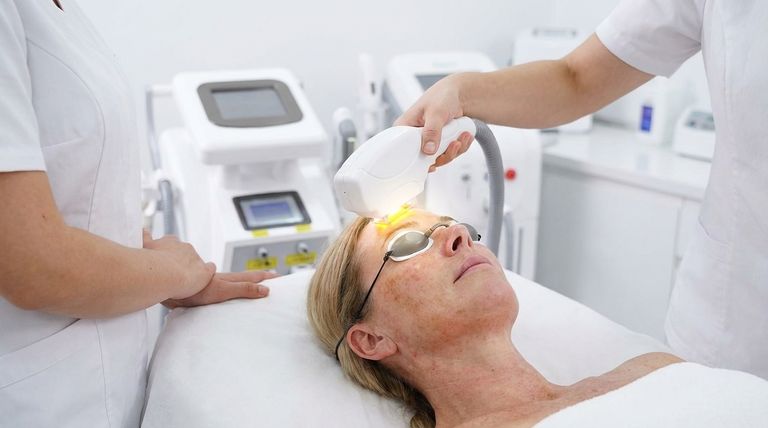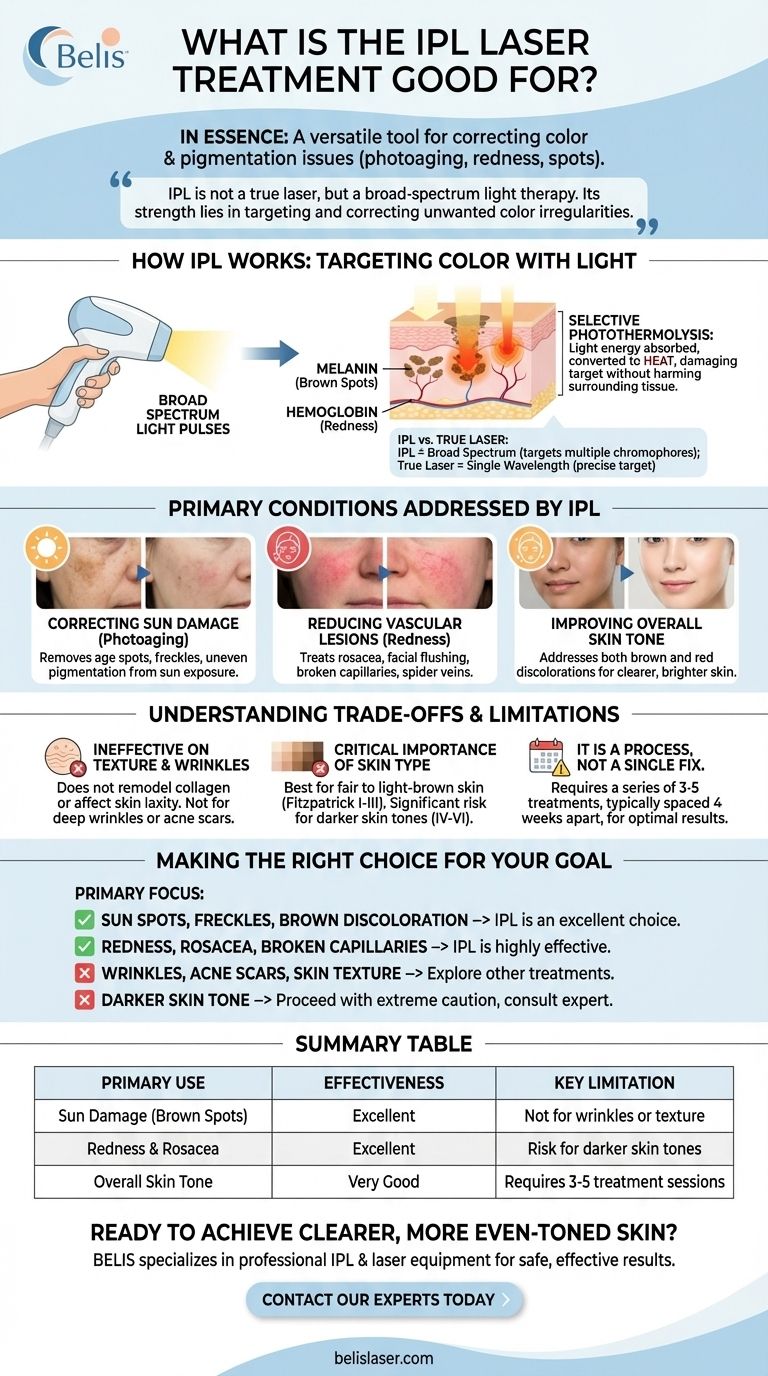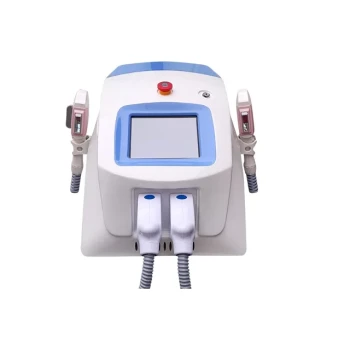In essence, an Intense Pulsed Light (IPL) treatment is a versatile tool for correcting skin issues related to color and pigmentation. It excels at undoing visible damage caused by sun exposure—known as photoaging—and is particularly effective for addressing red, brown, or splotchy skin on the face, neck, hands, or chest.
IPL is not a true laser, but a broad-spectrum light therapy. Its primary strength lies in targeting and correcting unwanted color irregularities in the skin, such as brown spots from sun damage and redness from broken capillaries.

How IPL Works: Targeting Color with Light
To understand what IPL is good for, you must first understand its mechanism. Unlike a laser, which uses a single, focused wavelength of light, IPL uses a broad spectrum of light delivered in high-intensity pulses.
The Principle of Selective Photothermolysis
IPL works by a process called selective photothermolysis. The light energy is specifically absorbed by targets, or chromophores, within the skin.
The primary targets are melanin (the pigment that causes brown spots and freckles) and hemoglobin (the red protein in blood vessels that causes redness and broken capillaries).
When these targets absorb the light energy, it is instantly converted to heat. This heat damages or destroys the target—breaking up pigment or collapsing a blood vessel—without harming the surrounding skin tissue.
The Difference from a True Laser
A true laser uses a single, concentrated wavelength of light to target one specific chromophore with high precision. This makes lasers ideal for very specific, targeted problems.
IPL uses a broad spectrum of light, meaning it can target multiple chromophores (like both melanin and hemoglobin) in the same session. This makes it a versatile tool for addressing general photoaging and improving overall skin tone.
Primary Conditions Addressed by IPL
IPL is the go-to treatment for a specific set of concerns, all rooted in skin discoloration.
Correcting Sun Damage (Photoaging)
This is IPL's most common application. It is highly effective at removing solar lentigines (age spots or liver spots), ephelides (freckles), and other forms of uneven, splotchy pigmentation caused by long-term sun exposure.
Reducing Vascular Lesions (Redness)
IPL is excellent for conditions involving redness. This includes rosacea, which causes persistent facial flushing, and telangiectasias, which are small, broken blood vessels or spider veins that commonly appear on the nose and cheeks.
Improving Overall Skin Tone
By treating both brown and red discolorations simultaneously, a series of IPL treatments can create a dramatically more even and uniform skin tone. The skin appears clearer, brighter, and less mottled.
Understanding the Trade-offs and Limitations
While effective, IPL is not a universal solution for all skin concerns. Understanding its limitations is critical for setting realistic expectations.
Ineffectiveness on Texture and Wrinkles
IPL's energy is absorbed by pigment; it does not significantly remodel collagen or affect skin texture. It is not effective for treating deep wrinkles, significant acne scarring, or skin laxity (sagging). Other technologies like fractional lasers or radiofrequency are required for those goals.
The Critical Importance of Skin Type
Because IPL targets melanin, it works best on fair to light-brown skin (Fitzpatrick types I-III). There is a significant risk of burns, blisters, or post-inflammatory hyperpigmentation (darkening of the skin) in individuals with darker skin tones (Fitzpatrick IV-VI), as the light cannot easily distinguish between unwanted pigment and the natural melanin in the skin.
It Is a Process, Not a Single Fix
One IPL session will produce some improvement, but optimal results almost always require a series of 3 to 5 treatments, typically spaced about four weeks apart. Maintenance treatments may be needed annually to maintain results.
Making the Right Choice for Your Goal
Use this guide to determine if IPL aligns with your primary skin objective.
- If your primary focus is sun spots, freckles, or brown discoloration: IPL is a first-line treatment and likely an excellent choice for you.
- If your primary focus is redness, rosacea, or broken capillaries: IPL is one of the most effective treatments available for these vascular concerns.
- If your primary focus is wrinkles, acne scars, or skin texture: You should explore other treatments like fractional lasers, microneedling, or chemical peels.
- If you have a darker skin tone: You must proceed with extreme caution and consult a board-certified dermatologist with extensive experience treating your skin type, as other lasers (like Nd:YAG) are often a safer choice.
Understanding what IPL can and cannot do empowers you to work with your provider to select the most effective treatment for your unique skin concerns.
Summary Table:
| Primary Use | Effectiveness | Key Limitation |
|---|---|---|
| Sun Damage (Brown Spots) | Excellent | Not for wrinkles or texture |
| Redness & Rosacea | Excellent | Risk for darker skin tones |
| Overall Skin Tone | Very Good | Requires 3-5 treatment sessions |
Ready to achieve clearer, more even-toned skin?
BELIS specializes in providing medical aesthetics clinics and premium beauty salons with professional IPL and laser equipment. Our technology delivers safe, effective, and consistent results for your clients' skin rejuvenation needs.
Contact our experts today to discover the right professional solution for your practice.
Visual Guide

Related Products
- Clinic Use IPL SHR ND YAG Laser Hair Removal RF Skin Tightening Machine
- IPL SHR+Radio frecuency machine
- 4D 12D HIFU Machine Device for Skin Tightening and Lifting
- 12D HIFU Machine Device for Facial HIFU Treatment
- IPL SHR Hair Removal Machine for Permanent Hair Removal
People Also Ask
- What are the negatives of laser hair removal? Understanding the Risks and Costs
- How can I tell if laser hair removal is working? Track These Key Signs of Progress
- Does IPL hair removal really work? Unlock Long-Term Hair Reduction with Science
- Can laser hair removal ever be permanent? Understanding the Reality of Permanent Hair Reduction
- What happens to the hair after SHR? Understanding the Gradual Shedding Process



















